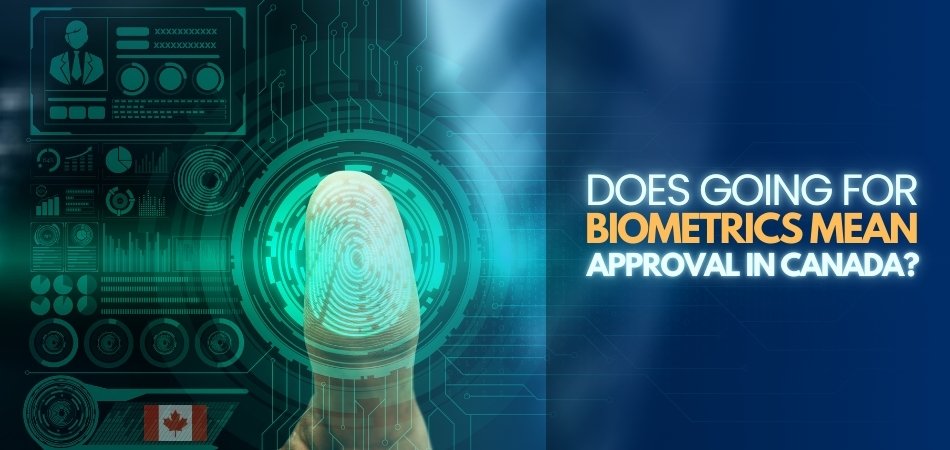No, going for biometrics does not mean your visa is approved. It only helps confirm your identity and begins background checks. Approval depends on your documents, eligibility, and other reviews done by IRCC. Biometrics are just one step in the process, not the final decision.
Many applicants get confused about biometrics because they see it as the final step. When they receive the biometrics instruction letter, they often believe approval is close. In reality, it’s just one early stage. To understand more about, “does going for biometrics mean approval in Canada?” read the full article below.
Does Going for Biometrics Mean Approval in Canada?
Many people think their visa is approved once they give biometrics. This idea is common, but it’s not true for the Canada visa process. Biometrics only help confirm your identity and start background checks. Keep reading below to learn what it really means for your visa status.

Role Of Biometrics
The main purpose of biometrics is to verify your identity. When you give your fingerprints and photo, IRCC links them to your file. This step helps officers confirm who you are before continuing with reviews. It’s only the start of the process, not the decision stage.
Meaning Of Biometrics Submission
Submitting your biometrics means you have completed a required step. It does not mean your visa is approved or refused. Once your details are recorded, your application goes to the next checks. Approval depends on eligibility, background, and document verification, not biometrics alone. Understanding the IRCC biometrics requirements helps applicants know when and why this step is needed, ensuring there are no delays or missing steps in the visa process.
Why Biometrics Are Needed
Canada collects biometrics to protect the immigration system. These checks help prevent identity fraud and make the process secure. Your fingerprints are matched with police and immigration records. If all looks fine, officers move forward with the rest of your visa review.
Why Biometrics Do Not Decide Approval
Giving biometrics only helps confirm your identity. The visa decision is based on full document review and background results. Even if your biometrics are clear, other checks may cause delays. Approval comes only after every part of your file passes review.
Steps After Biometrics
Once your biometrics are done, the system marks them as received. Then officers begin eligibility and background checks. They look at your purpose of visit, travel plans, and financial proof. Each part must meet visa requirements before a final decision is made.
Approval Depends On Eligibility
Your visa approval depends on how well you meet all conditions. Officers review your documents, purpose, and travel history carefully. For example, if you’re planning to attend a business conference in Canada, they verify your invitation and funding. Only when everything meets the rules can approval be granted.
Final Decision Stage
After all checks are done, IRCC makes the final call. If everything is complete and verified, you’ll get a passport request. If not, the refusal notice will explain the reason clearly. The time it takes varies by visa type and application load.
Biometrics are an early part of your Canada visa process. They help confirm your identity but do not decide your result. The final decision depends on how strong and clear your documents are. Stay patient and follow updates until your application reaches its final stage.
Why Biometrics Are a Mandatory Step in the Canadian Visa Process?
Every visa applicant must give fingerprints and a photo as part of the process. These small details help Canada confirm who you are before granting a visa. The system makes the process safer for both applicants and the country. Read below to learn why this step is so important for your visa approval.
Helps Confirm True Identity
Biometrics help officers confirm that every applicant is who they say they are. Your fingerprints and photo are compared with past records and global databases. This step ensures that no one else can use your identity. It also makes your future visa applications faster and easier to verify.
Prevents Identity Fraud
Collecting biometrics protects Canada from fake applications and stolen identities. The fingerprint and photo data are checked across security systems. This helps officers spot fraud or repeated visa attempts under false names. Many applicants wonder why Canadian visa processing requires biometrics, but it’s an essential part of maintaining secure and accurate immigration procedures across all visa types.
Supports Background Checks
Fingerprints and photos are sent to law enforcement databases for review. Officers use this step to see if an applicant has a criminal record or safety concern. If nothing suspicious appears, the file moves forward quickly. This process helps Canada maintain a safe and fair immigration system.
Improves Border Security
When travelers arrive in Canada, border agents can match them with their stored biometrics. This quick verification ensures that the person entering is the same who applied. It reduces mistakes and stops people from using fake passports. The system adds another layer of protection at every entry point.
Builds Trust In Immigration Decisions
Using biometrics gives officers confidence that their decisions are fair and accurate. They can review applications knowing that all personal details are verified. This builds trust in the immigration process and keeps records clean. It also helps honest travelers move through the system without extra delays.
Biometrics are required because they protect both applicants and Canada’s borders. The checks reduce fraud, confirm identity, and keep immigration records safe. Every fingerprint and photo makes the process fair for everyone. Completing this step carefully helps your visa application move forward with confidence and security.
What Happens After Biometrics for Approval in Canada? (Step-by-Step Guide)
After finishing your biometrics, your visa application goes through several checks. Each step has a purpose that brings your file closer to a decision. Officers look at your papers, identity, and background before making the final call. Read below to see the full step-by-step process clearly explained.
Step 1: Completeness Check
In this first step, IRCC makes sure your application is complete. Officers review all forms, signatures, and required papers. If anything is missing or unclear, they may return your file. Only after this check passes does your application move to the next stage of review.
Step 2: Eligibility Review
After the file is marked complete, officers start checking eligibility. They look at your purpose of travel, financial proof, and background. The goal is to see if you meet the visa conditions. A strong, well-prepared file helps this stage move faster toward approval.
Step 3: Background And Security Checks
Next, your fingerprints and photo are compared across security systems. This confirms your identity and checks for any criminal or immigration record. Police and security agencies may be involved in this step. If all is clear, your file continues smoothly to medical or final review.
Step 4: Medical Exam Review (If Needed)
Some applicants must pass a medical exam before approval. If required, an approved doctor sends your results directly to IRCC. Officers check if your health meets Canada’s standards. When your report is marked “passed,” your file moves one step closer to the final decision.
Step 5: Final Decision And Passport Request
This is the last and most important step. Officers review everything once more before deciding. If approved, you’ll receive a passport request for visa stamping. If refused, you’ll get a message explaining why your visa could not be granted.
Every step after biometrics plays a big role in getting approval. The process may take time, but it ensures fair and safe results. Keep your account updated and check for new messages often. Staying patient and ready helps your visa review move smoothly to the end.
How Long Does It Take After Biometrics for Approval in Canada? (2026 Timeline Guide)
The waiting time after biometrics depends on your visa type. Some applications move quickly, while others take longer because of extra checks or heavy workloads. Below is a simple table showing the average timeline for each visa type in 2026.
| Visa Type | Average Processing Time After Biometrics | Notes and Reasons for Delays |
| Visitor Visa | About 2–4 weeks on average | May take up to 6 weeks if the visa office is busy or more checks are needed. |
| Study Permit | Around 4–8 weeks in most cases | Can finish in 3–4 weeks if documents are complete, or take 10–12 weeks if verification takes longer. |
| Work Permit | Usually 6–10 weeks after biometrics | Some cases may take a few weeks to several months depending on job type and country of application. |
Processing times after biometrics can vary for every applicant. Factors like visa type, document accuracy, and visa office workload affect how fast your case moves. It’s best to stay patient and check your updates often. You can also use the IRCC processing time estimator to see the current average time for your specific visa.
Common Reasons for Visa Refusal in Canada Even After Biometrics
Many applicants feel confused when their Canada visa gets refused even after giving biometrics. This step only confirms identity, not approval. Visa officers still check your papers, background, and travel purpose. Below are common reasons that often lead to refusal.
- Missing or Weak Documents: Officers look for clear, correct, and complete papers. If documents are missing or unclear, your file becomes incomplete, and approval chances drop quickly during the review.
- Poor Travel History: Limited or risky travel records raise questions about intent. Officers prefer applicants with steady travel history showing lawful entries and returns to their home country.
- Low Financial Support: Lack of enough funds or unclear proof of income makes your case weak. Visa officers must see that you can cover your travel and living expenses in Canada.
- Unclear Purpose of Travel: When your travel reason is not clearly explained, it delays or harms your application. Always include letters or details that clearly show your real travel goal.
- Background Issues: Past criminal records or mismatched identity details can cause rejection. Officers check your background through security databases before approving any Canada visa application.
- Medical Problems: Certain untreated or contagious health issues may affect approval. Canada requires a medical clearance for many visa types to ensure public safety and prevent health risks.
- Mismatched Information in the Application: Any difference between forms, documents, or interview answers creates doubt. Officers treat inconsistent information as a warning sign and may reject your visa for inaccuracy.
Most refusals happen due to avoidable mistakes or missing details. Always double-check your papers before applying. Make sure all forms and facts match correctly. Staying honest, organized, and clear helps you reduce risk and improve your visa approval chances.
Myths vs Facts About Biometrics and Approval in Canada
Many people think biometrics mean their visa is approved right away. It’s common to hear stories that are not fully true. Biometrics are only one small step in the whole visa process. Read below to see the real facts behind the common myths about biometrics in Canada.
Biometrics Mean Approval
- Myth: Once you give biometrics, your visa is approved.
- Fact: Biometrics are only for identity checks. The visa office still reviews your full application before deciding.
Biometrics Speed Up The Visa Process
- Myth: Giving biometrics makes the process move faster.
- Fact: Biometrics are just one part of the steps. The speed depends on your application type and checks, not on biometrics.
If Biometrics Are Accepted, Decision Will Be Positive
- Myth: When biometrics are accepted, your visa will be approved.
- Fact: Accepted biometrics only mean they were collected correctly. The result still depends on your documents and eligibility.
Everyone Gets A Decision Right After Biometrics
- Myth: You will get a visa decision right after biometrics.
- Fact: Most people wait weeks or even months after biometrics. The wait time depends on your case, not on when you give them.
Biometrics are an important step, but they do not decide your visa result. They simply help confirm who you are in the system. The visa office looks at all parts of your application before making a choice. Be patient and check updates only from official sources.
How to Check Your Application Status After Biometrics for Canada?
After giving biometrics, many people want to know what happens next. You can check your status in two simple ways online. One method helps track your passport or documents, and the other shows visa progress updates. Read below to learn how to check both correctly and easily.
Using VFS Global (For Document Or Passport Tracking)
After submitting your biometrics, you can track your passport or document movement through the VFS Global website. This helps you know when your passport is ready for pickup after a decision is made. Follow the steps below carefully to check your update using your tracking details and birth date.
Step 1: Go To The VFS Global Website
Open the VFS Global website that handles visa services for Canada in your region. You can search “VFS Global Canada” and pick your country from the list. This website is the official source to track your document or passport status safely after your biometrics submission.
Step 2: Type Your Tracking ID And Date Of Birth
Find the Tracking ID printed on the receipt given at the Visa Application Centre. Type it carefully into the space provided. Enter your Date of Birth exactly as shown on your passport in the format DD/MM/YYYY. This helps match your tracking details to your personal record.
Step 3: Complete The Captcha For Security
Before viewing your tracking results, you must complete a small security step. Type the characters shown on the screen to prove you are not a bot. This simple check protects your data and keeps your application information safe from misuse on the VFS Global website.
Step 4: See If Your Passport Is Ready For Pickup
After finishing the captcha, the page will show your passport status. If it says “ready for collection,” the visa office has made a decision. You can then follow the collection steps provided by VFS. If it’s still processing, check again later for updates.
Using The IRCC Web Form (For Application Progress)
If you want to know about your application’s progress after biometrics, use the IRCC web form. This official method connects you directly with Immigration, Refugees and Citizenship Canada. It helps you check your visa status or send an inquiry when waiting for an update from the visa office.
Step 1: Visit The Official IRCC Web Form
Go to the official Immigration, Refugees and Citizenship Canada (IRCC) website. Look for the “Web Form” section under contact options. This is where you can send questions or check your visa progress. Always make sure you are on the real IRCC website for safety.
Step 2: Fill In Your Personal And Application Details
Enter your details carefully in the web form fields. You’ll need to provide your UCI (Unique Client Identifier), application number, and the type of visa you applied for. Double-check all information before submitting to make sure your request is connected to the right file.
Step 3: Write Your Inquiry And Send The Form
In the message box, write clearly that you want to check your visa status after giving biometrics. Keep your request short and simple. Once done, submit the form. You’ll receive a confirmation email from IRCC that they got your message and will review it soon.
Step 4: Wait For Your Application Update From IRCC
After submitting the web form, wait for an email response from IRCC. They usually reply within a few days, depending on your case. The update will tell you the current stage of your application. Keep checking your email, including the spam folder, for the reply.
Checking your status after biometrics is simple if you follow these two ways. VFS helps track your passport or documents after the visa decision. IRCC shows updates about your application’s progress based on IRCC application assessment rules. Always use these official websites only and avoid any fake tracking links online.
FAQs About Does Going for Biometrics Mean Approval in Canada?
Many people have questions after completing their biometrics for a Canadian visa. It’s normal to feel unsure about what happens next. These common questions help clear up confusion and guide you through the process. Read the answers below to understand what biometrics really mean for your application.
Can I Get Refused After Biometrics?
Yes, refusal can happen even after giving biometrics. Biometrics only confirm your identity and do not decide your result. The visa decision depends on your documents, background checks, and eligibility. Many applicants get refused after biometrics if their application does not meet the required visa standards.
Do I Need Biometrics Again If I Reapply?
You might not need to give biometrics again if they are still valid. In most cases, biometrics remain valid for ten years from the date you gave them. You can check your biometrics validity on the official IRCC website before reapplying for a new visa.
What If My Biometrics Do Not Show In My Account?
If your biometrics are missing in your account, don’t panic. It may take a few days for the system to update. Try checking again after some time. If they still don’t appear, contact IRCC using the web form and share your receipt details for support.
Do Biometrics Speed Up The Process?
No, biometrics do not make your application faster. They are only a small part of the visa process. Once you complete them, your file goes through background and eligibility checks. The total processing time depends on your application type and visa office workload.
If Someone Got Approved Fast, Will Mine Be The Same?
No, every case is different and processed separately. Even if another person got approved quickly, your timeline can vary. Factors like your country, visa type, and personal background affect the time. Always check your own updates through VFS or the IRCC web form.
Conclusion
Many people get confused about what happens after biometrics, especially when waiting for a Canada visa result. It’s easy to think that completing biometrics means your file is done, but it’s only one part of the full review. The other checks take time, so patience is very important.
The simple answer to does going for biometrics mean approval in Canada? is no. Biometrics confirm your identity, but they do not decide your visa result. The approval comes only after all reviews—like eligibility, background, and documents—are carefully checked by the visa officers.
To make your process smoother, always upload correct papers, follow IRCC updates, and check your account often. Avoid false news and only trust official sources. Stay calm and wait for real updates from IRCC. Wishing you the best of luck with your Canada visa approval.







